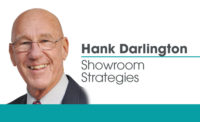The art of pricing

For years I have encouraged you to do abetterjob achieving higher gross profit margins on your showroom sales.
I’ve shared 20 different ideas on how to improve your margins and I’ve preached selling value to help inch up that all important GPM. I recently read a book that speaks directly to this subject. “The Art of Pricing … How to Find the Hidden Profits to Grow Your Business,” was written by Rafi Mohammed, the founder of Culture of Profit, a Massachusetts-based company that consults with businesses to help develop and improve pricing strategy. In my opinion the strategies outlined in the book apply to your showroom business the same as they would for a Fortune 500 company. The book has been around for several years and focuses a lot of attention on the issue of value.
Pricing should never be a “one size fits all” proposition. If you currently price your products this way you’re leaving money on the table. Yes, I’m well aware you have several categories of customers (plumbers, builders and homeowners to name the three main segments). You most likely have a different pricing structure for each group, but I’ll bet you don’t build in much, if any, variance within those structures.
You probably still work with a set discount off of a manufacturer’s list price — something similar to 40% off list for plumbers; 35% off for builders; and 25-30% off for homeowners. This most likely is built into the computer and takes an “act of God” to override it. If this sounds like your way of pricing you’ll be hard-pressed to improve your margins and you will continue to leave money on the table.
This reminds me of an incident that happened in one of my showrooms. We had a relatively new hire who had just sold her client a kitchen sink and faucet. I had been observing her selling skills and went up to her after the client had left the store. I complimented her on a great job including selling several add-ons for the sink. I asked her what price she sold the products for. She said, “List price on everything.” I said, “You’re kidding!” She replied, “Why, did I mess up?” I answered, “Certainly not!”
But if it had been me or one of our other salespeople we would have extended an automatic discount off of that list price. We had, like many (most) of you, thought we had to discount everything to everybody. Heck, we were wholesalers and that’s what wholesalers do! The homeowner/client in question never asked about a discount and was thrilled we had all the products she wanted in stock. This alone added a lot of value to that sale. I immediately rethought our pricing structure. And over the years by using creative pricing we inched our margins up to the very high 30s. You can, too.
So what Mr. Mohammed and I want to try to do is to get you to establish your selling prices with a more multidimensional approach. Mr. Mohammed suggests there are three different tools you’ll need to approach pricing decisions more effectively.
The right mindset: You need to look at pricing not as a search for a single optimum price point, but as a multiple price-point exercise in profit maximization. Now hear this: What dictates and drives your pricing decisions is knowing the value that exists in the mind of your buyer. It’s not other factors such as what competitors charge, your cost plus a set margin or a list price less a discount.
Pricing methodology: You need to find a way to break down value into its various components so you can better understand how your customers are thinking.
Maximize showroom profits:You’ll need pricing strategies that will enable you to maximize showroom profits. You need strategies that are easy to create and implement in the real world where you deal with clients day in and day out.
Mr. Mohammed states: “For every product in the world there are at least two people willing to pay different prices. If your company thinks about pricing primarily as an either/or price type of decision – you are leaving a lot of money on the table Pricing is not about setting numerical prices/discounts, it’s about developing a set of strategies to maximize your company’s profits. Pricing is more than a number. It’s a series of integrated strategies.”
Here is a real-life example I used several years ago when giving a talk to 100-plus people on this subject. I held up a generic, chrome soap dispenser. I asked audience members to write down the price they would sell this for to a homeowner in their showroom. The prices ranged from $30 to $95 with about $45 being the average. How could this be? It was the same product, same type of client and same selling effort involved. It just proves some people in the audience were more profit conscious than others.
Profitability over volume
It all comes down to your pricing mentality. Unfortunately, in my opinion too many wholesalers have a mentality that dictates volume over profitability. “More” is not always better! A strategy that states “selling a lot at a lower price and making it up in volume” (better discounts, under-the-table rebates, etc.) too often is used in showroom pricing strategies.
This is not the best approach. Most likely more than 60% of what you sell in the showroom will have to be special ordered. You’ll bring it in and sit on it for a period of time. Then you’ll probably deliver it to the jobsite. If you consider these as excellent value points along with your other added value points, you can more than justify higher margins on sales out of the showroom.
Too many showroom businesses are not very good at making pricing decisions. They end up using prices based partially on what competitors are charging, partially on cost and partially on market demand. Unfortunately this practice allows too many profit dollars to leak away. Here are three key concepts that should be put into practice.
Optimal business environment:You need to create a business environment that will allow you to benefit from better pricing: a nicely built-out
showroom, professional and well-trained sales consultants, and a variety of products and services.
Value and pricing: You need to understand the links between value and pricings. Identify and market your company, people and product value-added features.
Discount pricing: You need to appreciate different customers always are willing to pay different prices. Not all clients deserve or expect discount pricing on what they buy. They would rather receive great value and service.
You need to identify the true value of your products and services before you can develop a worthwhile pricing strategy. You have to understand how customers actually calculate the value of your product and/or service and what factors influence this valuation. Once you understand this and identify your value points, you can translate this information into the correct pricing for each of your customer categories. Value always is changing and you need to know these fluctuations and allow for them to have any chance of maximizing your profitability.
To develop your pricing strategies, the traditional search for the perfect price has to be replaced with a multi-priced mindset if you’re going to be able to capture missed profit opportunities. One price per customer category simply is not optimal. What is required is a series of strategies that will enable you to benefit from each customer’s unique valuation of your products and services. There are four primary strategies to create a workable multi-priced mindset.
Differential pricing: This is where you sell your products at different prices to different customers (plumber, builder, homeowner, etc.) and vary pricing within the groups.
Versioning: This is where you have a line of products offered at different levels and corresponding prices (Kohler, American Standard, Delta, Moen, Elkay, etc.). Mix up the pricing.
Segmented-based pricing: This includes strategies that activate otherwise dormant customers (those potential clients that do not now purchase through the showroom).
Pricing to market conditions:This is where you set higher prices to create high expectations of value or lower prices to sell off slow-moving and obsolete products.
I would encourage you to read Mr. Mohammed’s
book. It really underlines what I stress so often in my articles. Here are a few practical suggestions to help raise GPM.
- Have different pricing for plumbers on showroom sales.
- Work with “your” net price. Not list less a discount.
- Mix up the discounts. Don’t get stuck at a flat discount off list on everything.
- Don’t be afraid to charge list price or even a little bit more on selected add-on items.
- Don’t be afraid to charge list price or give only a very small discount on sales to homeowners.
- Don’t have your pricing locked into the computer. Make it easy to override.
- Be creative with your pricing strategies.
- Identify your many value points and “sell” them to your clients. Pricing is not simply an accounting exercise. Prices should reflect your value.
I know a number of wholesale and independent showroom companies that are enjoying gross profit margins in the high 30s and even low 40s. If they can do it – so can you!
Good selling!
Looking for a reprint of this article?
From high-res PDFs to custom plaques, order your copy today!





